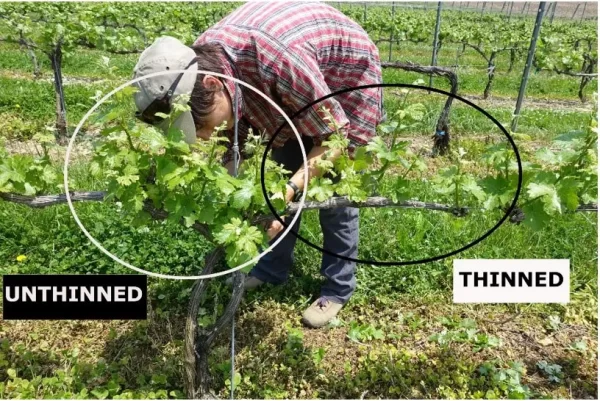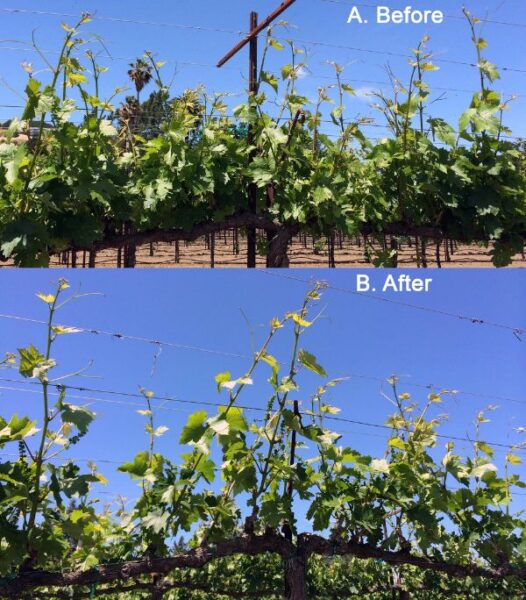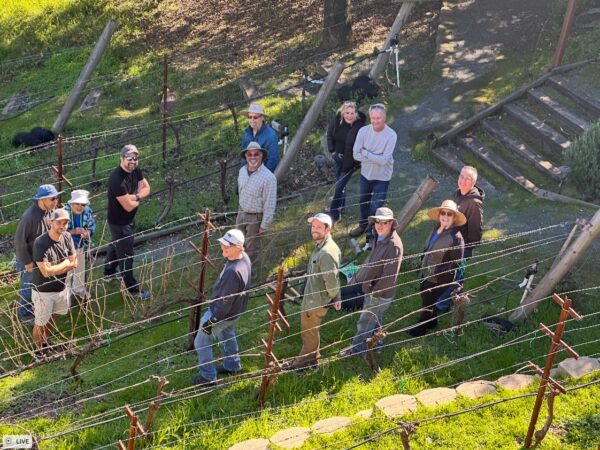There is still space available for the Canopy Management and shoot thinning techniques in the vineyard workshop.
Sunday, June 8, 2025 2-4 pm
Bill Saupe’s home
Please email Bill at Wasaupe@yahoo.com
Address:
111 Brodia Way. Walnut Creek
There is still space available for the Canopy Management and shoot thinning techniques in the vineyard workshop.
Sunday, June 8, 2025 2-4 pm
Bill Saupe’s home
Please email Bill at Wasaupe@yahoo.com
Address:
111 Brodia Way. Walnut Creek
LWGA Member, Lawrence (Larry) Haag ,died suddenly on May 9, 2025, from a fall on a hike in Moraga. Born in Waukegan, Illinois, Larry graduated from Waukegan Township High School, where he was a star baseball catcher. There he received the Chicago Tribune statewide Merit Certificate naming him to their League All-Star Baseball Squad and attracting the attention of several major league baseball teams. While in college, Larry was drafted during the Viet Nam War and was accepted into the Drill Sergeant Program in the U.S. Army Reserves, where he attained the rank of E-7, after serving for 7 years. He met his future wife, Carol, in high school and they recently celebrated their 55th wedding anniversary.
Following another bitterly cold Chicago winter of a wind chill of 77 degrees below zero, Carol and Larry decided it was time to move West and found Moraga, where they have resided since 1978. Missing Lake Michigan and being avid boaters, a year later they found Discovery Bay and have enjoyed being weekenders since 1979. They founded Scientific Symposiums International, a continuing medical education company, in 1994 and for three decades have held courses in numerous locations for some 10,000 physicians worldwide.
In 2007 Member Joao Magalhaes encouraged Larry and Carol to plant a vineyard in their backyard and the rest is history. Bill Scanlin has been the winemaker for their label, Rheem Valley Vineyard since they joined the organization. As members of LWGA, they have participated in many LWGA events, with Carol serving on the Board for many years in various positions and capacities, including helping to bring the AVA Lamorinda designation to reality.
They have a daughter, Maren, and two grandchildren, Ryan and Tyler.
Services are being held at 11 am, May 23, 2025 at Oakmont Memorial Park and Mortuary, Lafayette.
Limited attendance workshop. Sponsored by the Educational Committee.
Topic: Canopy Management and thinning techniques in the vineyard.
Sunday June 8, 2025. 2-4 pm
This will be at the home of Bill Saupe. Attendance is limited to 10 participants. Please email Bill at Wasaupe@yahoo.com. He will respond in order received.
Address: 111 Brodia Way, Walnut Creek.
Hi everyone, Pietro here with a couple vineyard and winemaking topics. Now that your vines are growing and we have had a few warm days you should be seeing some real growth happening. This is a reminder that you should be spraying approximately every two weeks (more often in wet or foggy locations) to control mildew, which grows whenever the temperature is between 70 – 85F. You should also be suckering the trunks of the vines while the suckers are soft and snap off easily – I buy a 10-pack of cheap gloves with rubber palms for this, and then move up to your fruiting cordons or canes and shoot thin those as well. If the suckers become too large, their removal damages the vine with rips and tears that leave exposed wood for diseases. Here are a couple pictures borrowed from Penn State and Lodi Winegrowers:


On to the technical stuff! Last week UC Davis held a presentation of current research topics at Greystone in St. Helena on both winemaking and viticulture research. I highly recommend attending these meetings since they are affordable and quite interesting. There will be one on June 4th at the legendary Oakville growing station focusing on vine growing which is linked here. I would attend if I could, perhaps you can catch a ride with Bill Saupe. Below is my summary of the presentations from last week.
The challenge is that there is a 3-year latency period from the initial vine infection. So if you are seeing that characteristic red-leaf all of a sudden, you were probably infected three years ago, and it has spread. We have vines in Lake County that came with red blotch as dormant grafts due to bad nursery practices, and it is spreading through insects.
Davis now recommends pulling individual vines if a singular isolated example shows up, but if two or more are present, they recommend pulling all vines within a 30’ radius and replanting. There is no known cure, and the vine decline is variable in speed. We have vines that top out at about 22 brix (photosynthesis shuts down) but I feel that they still contribute to the final blend. At some point they no longer will, and disease spreads in the meantime. Pulling vines is hard.
The big takeaway for me was a reminder of how important a reference standard is, which means first that when tasting with others we need to agree on what our words mean first off, for example consumers often confuse acid and tannin, and many will say a wine is “dry” when it is actually sweet but tannic. For ourselves as winemakers working on blends or questionable barrels, an easy trick is to compare with another sound bottle. For example, if you are trying to work Merlot into a tannic Cab within a Bordeaux framework, you really should pop open a benchmark Bordeaux-blend bottle, verify that it is sound, and use it as a springboard for comparison. We all get tunnel vision, whether in the cellar, at a wine competition, professional tastings or other critical tasting moments, especially in a room filled with barrels and bad lighting. Set yourself up for success and fight cellar palate by knowing your own blindspots. Tasting in threes is a good policy as well. Every blend, like every dish, gains something and looses something when blending. It could be something measurable like acidity, or the story of a vintage, and tasting with a few colleagues with different sensibilities and a shared language is helpful.
The general guidelines if we have a fire-year still hold the same though. Assuming the fire is more than a few miles away you have choices like just making white wines, avoiding toasted new oak barrels or chips, minimize pressing, leave a little sugar which keeps some of those compounds bound, or build a red so big that it “floods the zone” with other flavors so that smoke is suppressed as a sensory experience. Also, grapes vary wildly in their susceptibility with Petit Verdot, Mourvedre and Pinot Noir being very sensitive, Sangiovese and the high side, Cab and Merlot are medium, and some cultivars like Barbera are strangely low. It has no correlation to skin thickness, and the science is still out on how the bloom helps in the process. In their tests they found smoke compounds within the pulp after just 20 minutes, way faster than previously thought, and pre-veraison grapes are still susceptible!
In fact this is a topic I want to explore in the future for Lamorinda when we finally get monthly winemaker tasting together – I have done a few in Napa where we bring a bottle that we like and a “problem child” bottle and discuss, it is hugely interesting. How can we get a longer mineral finish into wine is the holy grail from my perspective, and a next level to reach for us, and this is a viticultural issue first and foremost with increasing mycorrhizal fungi growth in the roots. This can take us into topics like organics, weed control, mineral availability and all sorts of questions we need to spend a day discussing…
This kind of cool (or dangerous) as yeast evolve rapidly, and native oaks are acting as a giant petri dish that may have some local terroir residue.
Much of this research also looked closely at Twomey fermentations in their two winery locations nearby. Of interest, what they found in the second half of the fermentations as the wines go dry, is that the “in-house” cultured yeast – and they had particularly strong cultured yeasts like EC-1118 and Uvaferm 23 present in the cellar, in fact did not carry out the bulk of the work in fermenting to completion. The spontaneous ferments had a 1 or 2% population of these strong commercial yeasts, but in fact it was these hybrid local yeasts and spontaneous actors that did most of the heavy lifting, and had significant effect in DNA analysis. The price was a little more VA, and the big question remains of how much sulfur gives a level of security and how much destroys the native yeast mix. Some people go spontaneous but add 50ppm SO2, which is pretty much guaranteed to incapacitate most of the delicate spontaneous yeast and stuns everything until in-house sacch. yeast takes off, while 20 ppm is a common “soft” approach, mostly to suppress LAB, though wine pH and temperature are hugely important, as well as fruit quality. There can also be a moment of fear when your carefully maintained and barely-starting ferments go through an ethyl acetate day, which is produced by many of the wild yeast living on grapes. More damage = more sulfur or some other microbial inhibitor.
One last interesting yeast point, AMH yeast was used as a control, and the spontaneous ferments all went faster than the AMH fermentations. I have had trouble with AMH when it conflicts with another yeast strain since it is very sensitive and can go supernova as it fights it out with a stronger foe. That this particular yeast strain is indeed so slow is a usable bit of info for winemakers if you want a real low and slow inoculated fermentation – I love my slow 20-day ferments for Italian-style big reds. Just don’t mix it with other more vigorous strains.
In honor of the 20th anniversary of the LWGA, current LWGA members receive a free tasting. Our food vendor this year is Hearth Wood Fired Pizza! More details, along with tickets to be “purchased” ahead of time here: tinyurl.com/LWGA-April27
The LWGA General Meeting will follow the AVA Celebration at the Wine Thieves April 27th at 4:15pm. We are fortunate to have as our speaker, Pietro Buttitta, professional winemaker, grape grower, and LWGA board member, who will provide insights into the assets of the Lamorinda AVA and possibilities moving forward. This is a wonderful opportunity for members and guests to hear from an expert on our AVA with valuable insights as we celebrate 20 years!
Pietro Buttitta has spent the last 25 years working in food and wine, first as a professional chef in Portland, Or., San Francisco, and Napa Valley, and then as a full-time professional winemaker and grapegrower for the last 15 years. Pietro and his wines have been featured in Wine Enthusiast Magazine, Bloomberg and the SF Chronicle, and he has also produced wines for other brands in Napa and Paso Robles and out-of-state wineries as well as his own Prima Materia Vineyard & Winery label. A grape grower at heart, he has experience planting and managing vineyards and has consulted for wineries and vineyards in Lake County and Dry Creek Valley and worked with winery associations and grape growing organizations. He is a certified sommelier, has spoken at national wine conferences, and has directed and judged at wine competitions. For Pietro a global wine perspective is very important, from the latest Italian pruning techniques to historical fermentation methods and keeping pace with the world of wine, and he brings a unique perspective to the world of wine and food that he is excited to share while exploring the intricacies of grape growing and winemaking in the Lamorinda AVA.
LWGA Board
Hi All –
The Lamorinda AVA Celebration is April 27th and we’re looking forward to a great day sampling great wines and enjoying great company.
We still need three 6′ folding tables. Please let me know if you have one or more to share – we’d appreciate it.
Thanks!
Leanne Pilot
Hi All –
The 2025 AVA Celebration being held 4/27 is fast approaching! We are asking for people to help with set up in the morning from 10 – 12 and at the end of the day from 4 – 4:30. Please let me know if you are available to help at either time.
We are also interested in borrowing 6 folding tables. We will not be using table cloths so clean table tops are appreciated.
Finally, if anyone has flowers in their garden and would are willing donate some simple flower arrangements for the tables, we’d be very grateful. (All 6 do not have to come from the same person.)
If you are able to assist with any of these items, please let me know. The AVA Celebration Committee looks forward to seeing you all!
Thanks,
Leanne Pilot
Join us for an afternoon of wine tasting and food! Taste Lamorinda AVA wines and wines from AVA makers including:
In honor of the 20th anniversary of the formation of the LWGA, the Board would like to offer current LWGA members a free tasting. You must register for the event by logging into the LWGA website before “purchasing” tickets. If you are not logged in, the free option will not show. Limited to current members only please.
The Tasting event runs from 12-4pm on April 27 in the parking lot of Wine Thieves and will be followed by the LWGA general member meeting. Pietro Buttitta will present. If you haven’t met Pietro, is the latest addition to Local Vines and the wine maker for several wineries, including his own. This promises to be a lively and informative meeting!
Food available for purchase. For your non-member guests, entry price ($35 ahead of time and $40 on the day) includes a Lamorinda wine tasting glass and 5 tickets that can be used for tasting or purchasing wine by the glass. Bottles of wine to take home available for sale. Additional tasting tickets are 5 for $20.
Purchase tickets, including your member “priced” ticket at: tinyurl.com/LWGA-April27
Note that tasting tickets can be transferred if you are unable to attend though we don’t offer refunds
Venue: Behind Wine Thieves
Address: 3401 Mt Diablo Blvd, Lafayette 94549
Time: 12-4pm AVAnniversary; followed by the LWGA member meeting
NOET Vineyard had a lovely run from 2015 until this year. We have had a very robust vineyard from the beginning, with our first harvest being 500 lbs of Cabernet Sauvignon grapes just one year after planting the vines in early 2014. The harvest grew to 1,100, 1,600, and 2,000 lbs in subsequent years, and it has held steady between on or about 2,000 lbs per harvest ever since.
Our vineyard was initially managed by Sal Captain and was taken over by CVC after Sal decided to focus on his vineyard. Unfortunately, for reasons you may all know, in early 2024, CVC decided no longer to provide their services to the Lamorinda area.
That was very unfortunate indeed and very costly for us. The vineyard manager we chose was not up to the task. Several issues did not go right. The initial pruning was a deviation from the cane pruning, and there were way too many branches left in each vine; the spraying conducted during the summer was sub-par, and the canopy management was done incorrectly, leaving a lot of grapes exposed to direct sun, resulting raisins.
Since our vineyard benefits from the Moraga Gap and we get a lot of fog, we have not needed to water our grapes that much over the years, only a few times during the summer. One could argue that we did not give our grapes enough water this year. But since our neighbor, Captain Vineyards, tends to have a similar limited watering regime and their Cabernet harvest in 2024 was normal, that most likely was not the main issue but could have contributed to the results.
Since we were traveling a lot during the summer and had earlier learned to trust CVC in management, we did not expect this to happen. Unfortunately, we realized the full scope of the damage too late in the summer to be able to do anything about it.
The result was a significant amount of powdery mildew and raisins. We had to drop over 3/4 of the harvest, and we were able to collect only about 400 lbs of grapes.
This was a hard lesson to learn. We can only blame ourselves for not being more proactive about our vineyard and its management. We will be much more careful in the future as we consider any help we need on our vineyard.
After a couple of unsuccessful attempts due to weather, beginning last year, we finally managed to work between two storms to get in the pruning workshop. It was a beautiful day and perfect for the discussions and demonstrations for the well attended gathering. The takeaway is that pruning takes some thought since what you do now will affect not only this year’s harvest, but the following one as well.
The content of the workshop was as follows:
Demystifying Pruning
Cordon/spur vs Cane pruning techniques
Conversion methods between pruning techniques
Reading the vines for good pruning decisions
Vines should be pruned based on their capacity and how to determine that capacity
Selection of shoots for new growth and renewals
Decisions on number of buds for balance growth
Demonstrations of all of the above.
************************************
After the pruning workshop, we all gathered for a glass of wine and cheeses under a wonderful afternoon light in the vineyard, and still had plenty of time to watch the Superbowl! What a day.
This could be an annual event for our members if desired.

-